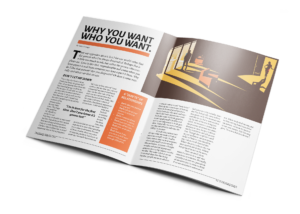
“Who the hell is Stan Tatkin?”, you might be asking. Those who have been in therapy with me will be familiar with the name, as I often bring up his writing regarding love and relationships. I even share an excerpt his publishers provides from his latest book, In Each Others’ Care: A Guide to the Most Common Relationship Conflicts and How to Work Through Them, because of how helpful I feel the suggestions are for couples. I admire his writing style, intelligence, compassion, and knowledge about what the human brain does when it is in a relationship with another.
However, I did not always have such high praise for Dr. Tatkin. I used to have a completely different opinion of him and his work. In this article I want to show how, as I gained experience as a couples therapist, he earned my respect, despite my continuing disagreements with some of his practice policies. I hope that in this time of polarization, my story will serve to show the value of both humility in professional growth, and willingness to change one’s mind given new information.
***
Several years ago I attended a conference for therapists who work with couples. This was before the COVID pandemic, when these were held in person, and they were a great way to connect with other professionals, learn new skills, and get out of town for a weekend. Dr. Tatkin was doing several presentations during the conference, as his profile as a well-known published author and speaker is significant, and his presence on the roster can influence people to attend.
After one of his talks, he was available to sign books in the lobby, and I took the opportunity to ask him a question about his work with couples. As a “narrative” therapist (one who works with the stories clients have about themselves, others, and the world), I wanted to know if he would ever confront a couple about the “story” they had about their relationship. I wondered if he would ever explore if the story they had was in fact the problem–that it was not working for who they are as a couple. For instance, it might be a problem if a couple has a story that the man is supposed to provide for the household when in fact the woman earns the money.
He listened to my question respectfully, but answered me by saying: “No, I would never do that. I would just tell them to grow up.” I remember being stunned by his answer, but trying not to let that show. Instead, I thanked him for his time, and I wandered away from his table.
This happened years ago, but for a long time I harbored the thought that Dr. Tatkin must be one of those therapists who has been working for so long that he has lost compassion for the couple he treats. It can happen! For years I held this negative view of him, and it allowed me to convince myself that I must know better. Yep, I have an ego!
***
Being a therapist is one of those careers that, in my opinion, requires a certain level of not just curiosity and compassion, but also humility, patience, and respect for the work. It asks that we take care of ourselves so that we can bring our full abilities and caring into sessions. It demands that we do our own work to minimize becoming reactive when client’s anger us or get angry at us.
Was Dr. Tatkin, in his response to me, displaying a lack of patience or reactivity for clients’ suffering, or was he perhaps letting me know that, in his work, compassion could look like confrontation? At the time I was convinced it was the former, and I remember hearing stories over time about his couples work that reinforced how I thought about this.
But then I myself worked for several more years, seeing couples in my own private practice. And along the way, I kept hearing more and more from Dr. Tatkin online in articles, videos, and discussions about the books he had completed and the work he does. What I began to struggle with is that the intelligent, empathic person he presented as in his videos and interviews was nothing like the harsh convention speaker I encountered at the book signing all those years ago.
I began to consider the idea that none of us are ever just one thing. Sometimes we are patient, sometimes we are not, sometimes we are caring, sometimes we are less so. As human beings, we hope to respond skillfully to whatever shows up around us, but that is not always the case, is it? Therapists are supposed to be better at this than most, but better does not mean perfect.
Life, even when we love it, can still be stressful at times, or we can just be tired. And careers, even when they are our passion, can tire us out or feel unsatisfying at times. Like all human beings, Stan Tatkin was neither an asshole or a saint. Like all of us, he could be both and everything in between. And this is when I started to listen to him more closely.
***
His most recent book, which I mentioned above, speaks loudly to me because of a few guidelines that he refuses to compromise on. I summarize them below:
- The needs of your relationship must ALWAYS come first.
- Love is not enough. Every relationship must define their shared purpose and vision.
- Agreements that you make together serve as guardrails to keep your relationship from running off the road. These agreements MUST be 100% agreed to by all parties, or they will fail.
In the recent trend of nurturing psychotherapy, clients can end up being coddled more than cared for. Sometimes the best way to care for anyone is to hold them accountable for who they are being, and support their efforts to be a better version of themselves. A therapist’s role can be more than listener–they can also be mentor, advocate, witness, and challenger.
Dr. Tatkin’s guidelines hold partners accountable for the health and wellbeing of the relationship, so they can no longer blame each other or outside forces. Imagine how powerful that can be–to not have any excuses for why you are not happy other than your choices and responses! This does not mean that if someone is abusing you, you are the cause of it. But you are accountable for your response to it, and your response can change your life (or save it!).
I believe that these guidelines need to be firmly followed, because it is natural for us to be selfish in life, concerned primarily about our individual needs. Even motherhood does not shift this very much–caring for a child has a selfish element to it. I want to stress that there is nothing wrong with natural selfishness like this, but it may not be in the best interest of the relationship.
In placing the needs the relationship first, you ensure not only that it thrives, but that you also thrive as an individual! One individual win usually ends up being a loss for both partners, so why not go for the win-win?
Your shared purpose and vision can be thought of as your relationship’s Mission Statement, guiding you down a shared path together, a path that can be changed at any time by both parties. Another way of putting this is that your relationship can only grow if you are both moving towards the same values.
Agreements act as guardrails to keep you on that path, and Dr. Tatkin stresses that caring partners will agree to hold each other accountable in a non-blaming way if one starts to veer off the road. Why wouldn’t we agree to do this for each other if we both have a vested interest in the continuation of the relationship?
***
In this article I have just given you a taste of what I have found of value in Dr. Tatkin’s work, and if your curiosity was piqued, I encourage you to read his books or watch his webinars and videos. Modern relationships cannot thrive by following the rules of the past, unless you are content with the narrowness of that kind of life together. Today’s complex marriages need guidelines that respect modern values and respond to them. This is how, over time, I grew to respect Dr. Tatkin’s approach to the work. He is on a mission to make relationships strong and secure, and coddling won’t achieve that goal.
I still don’t know if he is an asshole or not, but aren’t we all assholes from time to time? What I am certain of is that he is onto something that benefits anyone who takes the time to follow his lead. Today’s relationships need more than love–they need intention, follow-through, and shared accountability. This is what it means to be in each other’s care. And it turns out that new was right when he answered me way back when, because for some couples, being in each other’s care means they have to sort of grow up.









